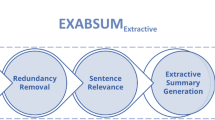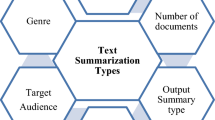Abstract
In this paper, we present a new hybrid system for automatic text summarization. First, vector space modelling is used to compute two original metrics of coverage and fidelity. The latter metrics are combined onto a unified Fidelity-Coverage (F-C) score using fuzzy logic theory. Then, a rhetorical analysis is performed on top of sentences having the highest F-C scores in order to achieve coherence. Conducted experiments on the Timeline17 dataset show that the proposed system outperforms state of the art extractive summarization models. Also, generated abstracts generally satisfy the three criteria of a good summary, namely coverage, fidelity and coherence.
Supported by the Canadian Social Sciences and Humanities Research Council.
Access this chapter
Tax calculation will be finalised at checkout
Purchases are for personal use only
Similar content being viewed by others
References
Mehdi A., et al.: Text summarization techniques: a brief survey. J. Comput. Lang. abs/1707.02268 (2017)
Andhale, N., Bewoor, L.A.: An overview of Text Summarization techniques. In: 2016 International Conference on Computing Communication Control and Automation (ICCUBEA), Pune 2016, pp. 1–7 (2016)
Yogan, J.K., Ong Sing, G., Halizah, B., Ngo, H.C., Puspalata, C.S.: A review on automatic text summarization approaches. J. Comput. Sci. 12(4), 178–190 (2016)
Nenkova, A., Vanderwende, L., McKeown, K.: A compositional context sensitive multi-document summarizer: exploring the factors that influence summarization. In: the 29th Annual International ACM SIGIR Conference on Research and Development in Information Retrieval, Seattle, WA, USA 2006, pp. 573–580 (2006)
Nenkova, A., Vanderwende, L.: The impact of frequency on summarization. Microsoft Research (2005)
Filatova, E., Hatzivassiloglou, V.: A formal model for information selection in multi-sentence text extraction. In: The 20th International Conference on Computational Linguistics, 2004, pp. 397–403 (2004)
Fung, P., Ngai, G.: One story, one flow: hidden Markov story models for multilingual multidocument summarization. In: The ACM Transactions on Speech and Language Processing, 2006, pp. 1–16 (2006)
Galley, M.: A skip-chain conditional random field for ranking meeting utterances by importance. In: The Proceedings of the 2006 Conference on Empirical Methods in Natural Language Processing, (NLP 2006), pp. 364–372 (2006)
Gupta, V., Lehal, G.S.: A survey of text summarization extractive techniques. J. Emerg. Technol. Web Intell. 2(3), 258–268 (2010)
Svore, K.M., Vanderwende, L., Burges, C.J.: Enhancing single-document summarization by combining RankNet and third-party sources. Microsoft Corporation (2007)
Burges, C., Shaked, T., Renshaw, E., Lazier, A., Deeds, M.: Learning to rank using gradient descent. In: Proceedings of the 22nd International Conference on Machine Learning, (CML 2005), ACM, pp. 89–96 (2005)
Hannah, M.E., Mukherjee, S.: A classification-based summarisation model for summarising text documents. Int. J. Inf. Commun. Technol. 6, 292–308 (2014)
Barzilay, R., Elhadad, M.: Using lexical chains for text summarization. In: Mani, I., Maybury, M.T. (eds.) Advances in Automatic Text Summarization, pp. 111–121. The MIT Press, Cambridge (1999)
Kundi, F.M., Ahmad, S., Khan, A., Asghar, M.Z.: Detection and scoring of internet slangs for sentiment analysis using SentiWordNet. Life Sci. J. 11, 66–72 (2014)
Mann, W.C., Thompson, S.A.: Rhetorical structure theory: toward a functional theory of text organization. Interdisc. J. Study Discourse 8(3), 243–281 (1988)
Tran, G.B., Tran, T.A., Tran, N.K., Alrifai, M., Kanhabua, N.: Leverage learning to rank in an optimization framework for timeline summarization. In: TAIA workshop, SIGIR 2013 (2013)
Luhn, H.P.: The automatic creation of literature abstracts. IBM J. Res. Dev. 2(2), 159–165 (1958)
Mihalcea, R., Tarau, P.: TextRank: bringing order into texts. In: Lin, D., Wu, D. (eds.) Proceedings of EMNLP 2004, Association for Computational Linguistics, Barcelona, Spain, Association for Computational Linguistics, Barcelona, Spain, pp. 404–411 (2004)
Erkan, G., Radev, D.R.: LexRank: graph-based lexical centrality as salience in text summarization. J. Artif. Intell. Res. 22(5), 457–479 (2004)
Torres-Moreno, J.-M.: Automatic Text Summarization. Wiley, London (2014)
Author information
Authors and Affiliations
Corresponding author
Editor information
Editors and Affiliations
Rights and permissions
Copyright information
© 2019 Springer Nature Switzerland AG
About this paper
Cite this paper
Ben Ayed, A., Biskri, I., Meunier, JG. (2019). Automatic Text Summarization: A New Hybrid Model Based on Vector Space Modelling, Fuzzy Logic and Rhetorical Structure Analysis. In: Nguyen, N., Chbeir, R., Exposito, E., Aniorté, P., Trawiński, B. (eds) Computational Collective Intelligence. ICCCI 2019. Lecture Notes in Computer Science(), vol 11684. Springer, Cham. https://doi.org/10.1007/978-3-030-28374-2_3
Download citation
DOI: https://doi.org/10.1007/978-3-030-28374-2_3
Published:
Publisher Name: Springer, Cham
Print ISBN: 978-3-030-28373-5
Online ISBN: 978-3-030-28374-2
eBook Packages: Computer ScienceComputer Science (R0)




